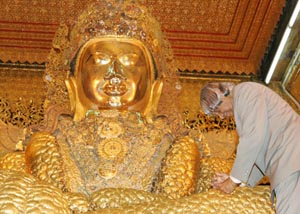|
Travel Sites Visit
Goa, Karnataka,
Kerala, Tamil
Nadu, Andhra Pradesh |
Kalam
visits sacred Shwedagon Pagoda
by
Gaurav Srivastava
Yangon: President APJ Abdul Kalam visited the historic Shwedagon Pagoda on Thursday morning. The visit to the sacred shrine lasted a little over an hour, during which Kalam was briefed about the shrine's history and its relevance to the people of Myanmar. The Shwedagon Pagoda enshrines the sacred hairs of Lord Buddha. It is often referred to as "The Pagoda of Sacred Living Hairs." It is Myanmar's most prominent and sacred pagoda.
 |
|
The
Indian President, Dr. A.P.J. Abdul Kalam, pasting a golden leaf
on the statue of Buddha while on a visit to Mahamuni Pagoda in Mandalay
in Myanmar.
|
According to legend, soon after Lord Buddha attained samadhi more than 2,500 years ago, his relics were divided into eight equal parts and enshrined in the great stupas built that time. Later, Emperor Ashoka of the Mauryan Dynasty recovered one of the eight parts and distributed it in equal parts among 84,000 stupas. In Myanmar,the stupas came to be known as pagodas. The Shwedagon Pagoda is located atop a hill 58 meters high and its golden mast rises a further 99 meters. Little is known about what happened to the shrine between the period of its foundation and the 14th century. In the 14th century, it was enlarged by the King of Bago. Subsequent kings of the Mon Dynastry carried out further reconstructions and enlargments, besides renovations. The last major reconstruction effort was carried out in the 18th century.
In 2003, Vice President Bhairon Singh Shekhawat donated coloured glassses worth Rs.three lakh to the pagoda. President Kalam's agenda for the day includes participation in a tree-planting ceremony at the People's Park here. He will then proceed to the Pyithu Hluttaw to make a courtesy call on Senior General Than Shwe, the Chairman of Myanmar's State Peace and Development Council. This will be followed by an agreement signing ceremony. He will then proceed to the No.1 Basic Education High School located in the Dagon Township, where he will interact with local Myanmarese students. After a private lunch at the Park Royal Hotel, Kalam will proceed to the Myanmar Info-Tech Park in the afternoon and will spend a couple of hours there. A visit to the mausoleum of India's last Mughal Emperor Bahadur Shah Zafar is scheduled to take place at 4. 20 p.m. (Myanmar time). He will then return to the hotel and then proceed for a state banquet and a cultural performance at the Pyithu Hluttaw The objective of the trip is to consolidate India's economic and political ties with these two countries. This is Kalam's first visit to both the countries as President and he will be accompanied by Foreign Secretary Shayam Saran and other senior functionaries of various ministries. In his three-day visit to Myanmar, the President will give a fresh impetus to political understanding between New Delhi and Yangon. India has been keen to tap Myanmar's gas reserves and this could be routed through a pipeline to the northeast or any other option, including converting it into liquefied natural gas (LNG) and shipping it to India.
Kalam visits 'Apravasi Ghat' in Mauritius
Port Louis: The visiting President A P J Abdul Kalam today visited the `Apravasi Ghat` where the first batch of Indian indentured labourers arrived in the 1830s. Formerly known as the Coolie Ghat, it was proclaimed a National Monument in 1987 as it forms part of the cultural heritage of Mauritius.
 |
|
The
Indian President, Dr. A.P.J. Abdul Kalam, addressing Indian nationals
in Mauritius at Cyber Towers in Port Louis
|
The Government of Mauritius has approved a plan for the restoration and development of the Apravasi Ghat to pay tribute to the memory of the Indian indentured labourers and to preserve the monument as a historical building which would reflect the cultural heritage of Mauritius. Throughout the indentured period from 1834 up to 1924 a total of about 450,000 workers came to Mauritius. About two thirds chose to make Mauritius their new homeland. On the last day of his three-day visit to the picturesque island republic, the President placed a garland on the plaque called `the Unknown Immigrant`.
Officials
said that nearly 70 percent of Mauritian citizens can trace their roots
to India through an ancestor who would have entered Mauritius through
the Apravasi Ghat. The place also functioned as an immigration office
for keeping immigration registers, delivery of tickets to old and new
immigrants, setting of taxes and other dues required from them, and the
confirmation of Indian marriage certificates. Known as the "Gateway of
the Indian Diaspora in Mauritius", the depot used to maintain a register
of names, pen sketches/photograph and place of origin of every immigrant.
Due to theses records, most fourth or fifth generation persons of Indian
origin here are able to trace their ancestors. The Apravasi Ghat project
consists of restoration of the Apravasi Ghat site, preservation of the
existing structures, reconstruction of two or three buildings, setting
up of a museum and auditorium. The ghat is also proposed to be placed
in United Nations educational, scientific and cultural organization (UNESCO's)
World Heritage Site List. The Government is also contemplating the possibility
of initiating an "Indentured Labour Route" Project with the collaboration
of the Government of India on the same lines as the UNESCO's project known
as "The Slave Route". This will shed further light on each aspect of the
massive movement of Indian emigration overseas. In 1970, the then Prime
Minister Indira Gandhi had visited the site and other Indian dignitaries
over the years. The visits by the Indian leaders have presented a new
dimension to this heritage site, making it a symbol of Indo-Mauritius
ties.
Mar 13, 2006
Tourist
offices
in India
|
Window
on India |
|
News
Links |